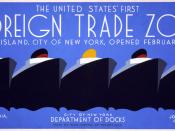Foreign Trade Zones and Its Economic Beneficiates
Throughout the centuries, various forms of duty-free areas have existed in many parts of the world to facilitate trade by lessening the effect of custom restrictions. This type of free trade is what the United States trade policies are based on. Within the theoretical model of free trade world leaders has recognizes the economic beneficiates of free trade; world leaders acknowledges that there will be a cost resulting from free trade policy but they are negligible. In reality, however, free trade has benefits and costs. No doubt, the benefits far outweigh the costs; however, the costs are very real. The United States Foreign-Trade Zone policy allows the United States economy to enjoy relatively greater benefits from its free trade initiatives. The various benefits offered by the Foreign- Trade Zone program make it an effective response to the problems that arise when the $8.5trillion
dollars U.S. economy operates within the changing international environment.
The U.S. Foreign -Trade Zones program was created by the Foreign -Trade Zone Act of 1934. The Foreign -Trade Act was one of two key pieces of legislation passed in 1934 in an attempt to mitigate some of the destructive effects of the Smoot-Hawley Tariffs, which had been imposed in 1930. The Foreign - Trade Zone was created to "expedite and encourage foreign commerce" in the United States. To accomplish this task the United States designated geographical area, in adjacent to Customs Ports of entry, where commercial merchandise receives the same Customs treatment it would if it were outside the commerce of the United States.
These special geographic areas were established in or adjacent to U.S. Ports of Entry and are under the supervision of the U.S. Customs Service. The FTZ program has grown profoundly over the last 30 years.



Works cited?
The grammar on this could be cleaned up a bit, but the content is good.
However, the thesis fails to cite ANY other work. All of the statistics and the quotes had to come from somewhere!
1 out of 1 people found this comment useful.